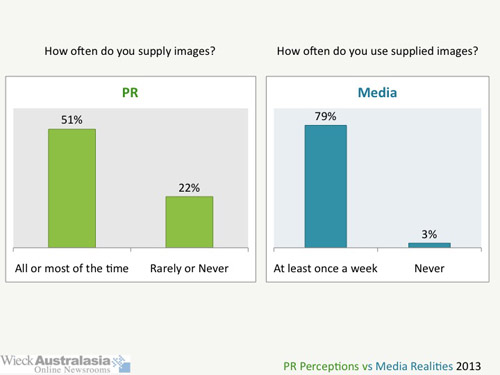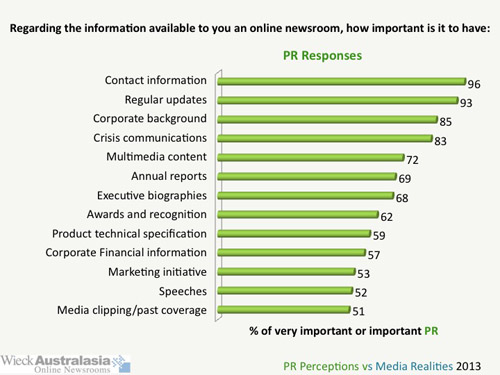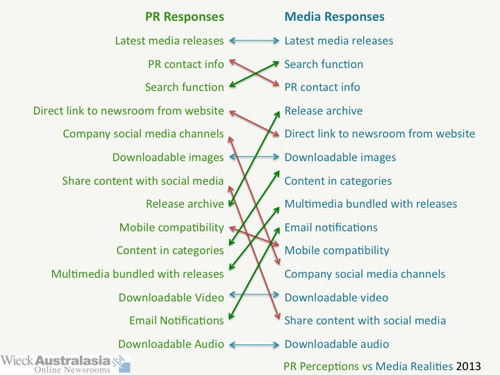Ladies and Gentlemen, welcome to what I’m sure will be a worthwhile end to a great conference.
My name is Warren Kirby and I’m CEO of Wieck Australasia, builders of online newsrooms. We specialise in building online portals that are designed to deliver news releases, images, audio and video to the media. I began my career on the Australian before moving into the world of PR. I started working with online newsrooms back in 1997 in response to the changing nature of the media industry and the emergence of the Internet as a viable tool for providing the media with PR material.

Today I’ll be presenting our whitepaper titled PR Preceptions and Media Realities in 2013.
We undertook this survey to gauge how the PR industry is responding to changes in the symbiotic relationship between the media and corporate communicators caused by the evolution of the Internet.
The world’s ever-increasing appetite for consuming and sharing news online has driven significant change in media circles, from the type of content required, to who is now counted as a journalist and how they create interesting and engaging stories.
While there is a significant amount of data generated out of the US, there is virtually no information available on Australian media, nor the way the PR industry has adapted to the changes - until now
.
The results point towards a growing divide between media realities and PR perceptions, especially when it comes to the use of multimedia. They’ve demonstrated that in today’s media, journalists need more than just story ideas and words on a page from PRs; they require professional, meaningful images, video and other multimedia content on a daily basis. In short, they are desperate for content.
Protest as they may, the media’s reliance on PR professionals to provide content has been increasing exponentially since the early 1990s. There is no doubt that the gap that has been created by the ever shrinking newsroom is being filled by the PR industry as both the instigators and providers of news.
Whilst almost every journalist agreed that they used PR materials and support on a daily basis, most would prefer to be able to access this information autonomously via an online newsroom. However it’s also clear that a static repository of text based information and no ability to download multimedia content is not the answer.
The results suggest new practices that PRs can adopt to strengthen their media relationships and thrive in the new media environment. I should also point out that based on the responses, many PRs have an understanding of how great the opportunities to provide content are but a lack of budget inhibits their ability to do so. It is our hope that this whitepaper provides you with all the evidence you need to help open up the purse strings a little so you can do your job more effectively.
So, let’s get into it.
In September and October of this year we surveyed members of the media and the PR industry simultaneously.

In green, we have PRs who:
Gave us 346 responses with the majority supplying to all major media types
49% identified themselves at a Director of Communications or Senior Consultant level
89% identified themselves as proficient or expert at using the Internet
An additional 3% claim to have tutored Tim Berners-Lee, who is of course, the inventor of the world wide web.
In blue we have the media who:
Provided 441 responses from across newspaper, magazine, television, radio and online.
74% identified themselves as a journalist
92% identified themselves as proficient or expert at using the Internet
Again, an additional 3% claim to have tutored Tim Berners-Lee

After establishing who we were dealing with, we asked PR’s their perception of how media prefer to receive information and compared that with the media’s reality.
The first question was,
“How would you prefer to receive notification of updated news or PR material?”
76% of PRs thought the media would prefer emails, 17% thought they’d like a phone call, 5% thought Twitter would be the preferred choice and only 2% thought they would use Facebook.
[enter] The reality is that 95% of media prefer an email, just 3% say they want a phone call and only 1% prefer Twitter or Facebook.
As will continue to become clear, this hints at the media’s need to be empowered to gather or filter information, in the fastest way possible and on their terms.
It should also be noted that while email is the clear preference, it’s not always easy for your information to stand out in the crowd. Some journalists claimed to be receiving more than 150 emails per day. Overwhelmingly the most important tip here is to ensure the release newsworthy and well written.
To quote one journalist, "Tell us a story, don't tell us about you.

To get a bit more detail about the way media seek out information - and how PRs perceive they do - we asked them to rate their preferred method from a list of 6 options.
We also asked respondents to do this based on whether they were researching on day-to-day basis and again during a crisis. In both cases we added together the first and second choices to get the combined totals.
[enter] The PR perception is that a phone call would be the preferred option when it comes to researching on a day-to-day basis followed by a visit to an online newsroom, then Twitter as the third option. These were followed by Google, Facebook and other news outlets.
When it comes to the media, however, the reality is quite different.
[enter] Your online newsroom is their first preference when it comes to researching news.
A quick Google search comes in next. A distant third is the phone call. In fact, less than half the number of journalist will attempt to call you than those that will head to your online newsroom. What may also come as a surprise is the lack of interest in social media with Facebook and Twitter down at the bottom of the list.
[enter]As a side by side comparison, the differences are stark. When it comes to researching or following up on a potential story, journalists prefer to do their own legwork.
The idea of media wanting to be empowered is becoming clearer.

When it comes to a crisis, things look a little different.
[enter] The PR responses gave us the phone call in first place again. online newsroom again came in second and was followed very closely by Twitter in third place.
Then we see Facebook, other news outlet and google as last.
[enter] In the media’s case, a phone call is the first preference during a crisis
The online newsroom is next and that’s also closely followed by Twitter. This is then followed by Google, other news outlets and Facebook.
[enter] In this instance, a phone call to a PR professional is easily considered to be the best course of action, although it should be noted that it’s still not as popular as corporate communicators think it is. Having access to readily available information on a company website or via an online newsroom isn’t far behind.
Twitter is also viewed more favourably by media in a crisis situation, when speed is of the essence in filing the story. Media can also track news more effectively as the story develops by using hash tags. The importance of Twitter during a crisis - and apparently only during a crisis - implies that for journalists this medium is important for crowd sourcing rather than relying solely on the corporate response.
In recognition of the increasing amount of online publishing, we asked a series of questions about multimedia use.

We asked PRs, “How often do you supply images?” and 51% said they do all or most of the time and 22% said rarely or never.
[enter]We asked the media “How often do you use supplied images?” 79% said at least once a week and only 3% said never.
97% of Australian media use supplied images 22% of the PR industry are ignoring that demand.
If you think that’s a big gap, hold onto your latte’s!

We asked PR’s “How often do you supply video content to media?”. Only 2% supply video all or most of the time and 76% rarely or never give out video content.
When asked why, 36% said there was no need and 56% said there wasn’t the budget.
[enter]When we asked the media “How often do you use supplied video content?” 45% use supplied video at least once a week. Only 18% say they don’t use it at all.
So on one hand we have 82% of the media using supplied video content and only 2% of the PR industry regularly supplying it. Needless to say, we recommend the 56% who don’t have the budget should start looking for it.

Finally we asked PRs “How often do you supply audio content”. 3% said all or most of the time and 79% said rarely or never. This result is more surprising when you factor in the fact 82% of PR respondents supply to radio.
[enter]We asked the media “How often do you use supplied audio content?” and 26% said they do at least once a week and 34% said never.
For the price of a small recording device, or even simply recording via your phone, PRs could be supplying two thirds of the media with content they will use, not to mention value add to those that may not directly use it but listen to an audio file so they can directly quote the speaker.

Multimedia is now a major requirement for almost all media outlets in 2013 yet it’s an area largely ignored by PRs. There is huge potential for communicators to captialise on journalist’s need for multimedia and in doing so, there’s every likelihood that campaign penetration will be significantly improved.
The growing importance of supplying multimedia assets has creating a new danger zone for PRs in regards to copyright though.

Almost 30 per cent of PR professionals do not check the copyright status of the multimedia they supply so, by default, believe media will verify the copyright status. In reality, 97% of journalists presume supplied images or multimedia content is either copyright free or copyright free for media.
If the images or multimedia materials are being supplied to media for publication, it is the responsibility of the PR professional to ensure that no copyright infringement is occurring.

Upcoming changes from the Copyright Agency are also expected to apply to social media channels and PRs should be prepared to review content that has been posted to ensure that it can be legally shared too.
Now we’ve established that most journalists will go to your online newsroom to both research on a day-to-day basis and during a crisis situation. It’d be nice to know content they are looking for.
We’ll start again with the PR perception of types of content that are important to media.

The top 5 are contact information, regular updates, corporate background, crisis comms and multimedia content.
When it comes to media reality, [slide15] the top 5 are exactly the same, just in a slightly different order. we have contact information, regular updates, crisis comms, background information and multimedia content.
When we compare the two side by side, [slide16] it gets a little messy after the top 5.[enter] If we look a little deeper into the things that media value more highly than PR think they do you’ll notice that items related to self promotion tend to be less important. [enter] This ties in exactly with the overwhelming majority of pet-peeves comments that suggest ‘more focus, less puffery’.
Now we know that most media prefer to get their information autonomously. We know the types of information they prefer and we know they are almost all using multimedia assets but when asked how they’d prefer to receive multimedia, we received a curious response.

Only 23% say via direct download from an online newsroom and 64% say email. It’s odd because what PR professional hasn’t heard a journalist complain that large, multimedia files are clogging up their inbox? This also came through very strongly in the pet peeves - where there were many comments that said “don’t send large attachments via email” so how do we explain it?
The first clue came from comments that said “don’t send big attachments, give me a link”
The next clues were from comments made that show too many journalists have been burned by poor experiences when accessing support materials from a company website or online newsroom. This is underlined by the functionality that is currently available to them.
We provided a list of features and asked how important each of them were.

In the PR responses, the top 5 rated extremely or very important were; Latest media releases, PR contact information, Search function, a direct link from the public website to the newsroom was next on the list, and having access to company social media channels. Downloadable images just missed out.

The media reality is again quite different with Latest media releases topping the list, Search function second, and PR contact info third. Release archive is next followed by Direct link to newsroom from website and Downloadable images tied in fifth place.

When we compare these side-by-side we can again see that there is quite a gap between perception and reality. In particular, social media is not nearly as important to journalists as PRs think it is but this isn’t where the biggest concern lies.
When we have a look at the features that both the media and PR’s rate as very or extremely important and then ask whether the PRs have these features available on their newsrooms, we find that there is a disconnect between knowing what should be offered and what is actually being offered.

Both media and PR rate offering the latest media releases as the most important thing a newsroom can offer, yet 19% don’t provide them. Over 90% of journalists and PRs consider PR contact information and very or extremely important but you won’t find them on 23% of corporate newsrooms. Also over 90% for both sides of the fence is having a search function yet 43% of PRs do not have one on their newsroom.
36% don’t have a direct link from their website, 38% don’t have access to company social media channels, 60% don’t offer downloadable images and 53% don’t have a release archive.
There is little wonder journalists have had poor experiences when trying to access media material. Journalists want to gather the information for themselves. They want to use multimedia assets. They want emails but don’t want their inboxes clogged. And for the most part, PRs recognise the need to facilitate them but for one reason or another aren’t actually implementing a solution.
As someone who specialises in online newsrooms my response is ...
To wrap up, here’s a few tips, based solely on feedback from the survey, that will go a long way towards improving your media relations.
- Have a real story to tell, not just company updates
- Make sure you provide contact details including out-of-hours contact
- Media release should be no longer than one page
- Provide multimedia with releases
- Recognise that deadlines are constant and immediate
- Provide a solution that empowers the media to work autonomously

Free hard copies of the whitepaper are available here and at out stand outside. We will be have an electronic version available for download from our newsroom. We are also making available raw survey results, also downloadable from our newsroom, for those who love numbers.

I’ll leave you with a few more pet peeves that represent the majority of responses. I should point out that while some may seem negative, they are all tips on how to improve your relationships with journalists and therefore meant to be constructive. It’s worth noting that two thirds of journalists surveyed chose to leave a pet peeve.